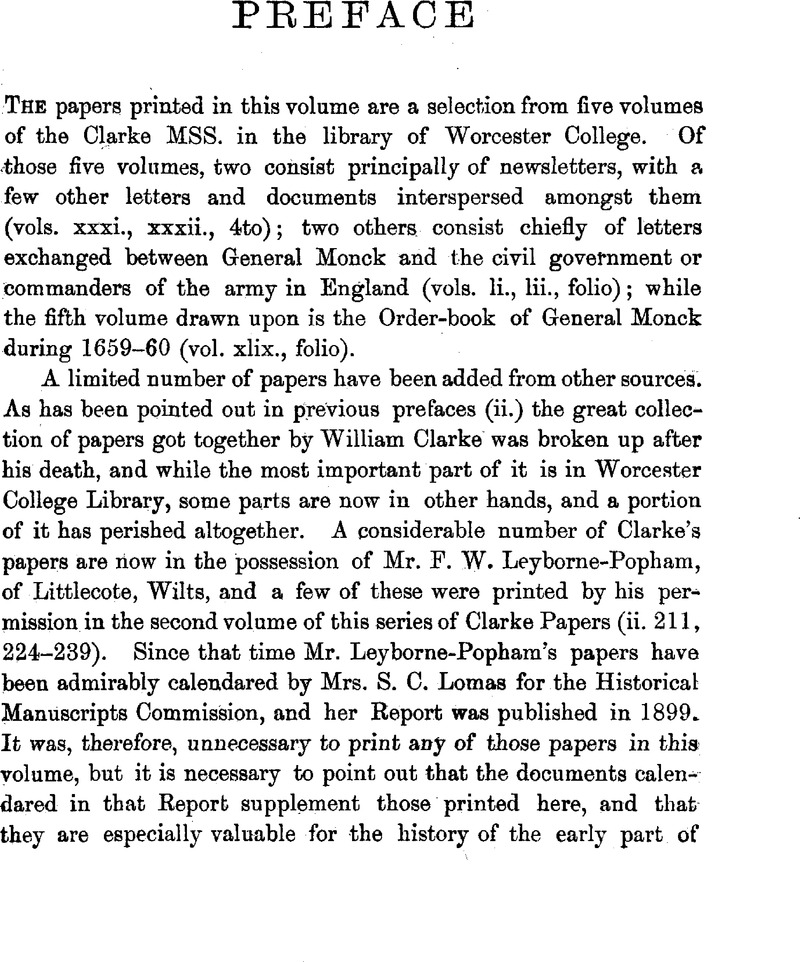Article contents
Abstract

- Type
- Preface
- Information
- Copyright
- Copyright © Royal Historical Society 1901
References
page xvi note 1 Letter xxix. in Toland's pamphlet is an obvious forgery. It was originally printed in 1660 as ‘A Letter from General Monok to King Charles, son of the late King Charles of England ; together with King Charles's answer thereunto.’ It is reprinted in the Somers Tracts, vi. 557, ed. Scott.
page xviii note 1 Monok seems to have sent similar letters to other parts of England, urging in still more explicit terms a rising in arms. ‘We have apprehended a person that had two letters from General Monck sewed in his doublet; they were directed to nobody, but the messenger said he was to carry them to —, where directions were to meet him to whom they should be delivered. The substance of them was to invite them to an insurrection in the West, and to seize upon Exeter as a place to make head in; and tells them that when the greatest part of the army was drawn to oppose him, then London would rise and destroy the rest; so that you may see, here is the second part of Sir George Booth. The letter was written by William Clark, and signed by Monck's own hand : I saw it.’ Letter from Colonel John Pearson, dated ‘Northallerton, November 1,’ quoted in Mackinnon's History of the Coldstream Guards, i. 77.
page xxii note 1 Sir Andrew Bruoe's letters (pp. 205, 223) are specially noticeable. Monck had recommended him to the Protector on November 23, 1654, to be appointed a judge in lieu of Sir James Hope. ‘Hee is,’ said Monck, ‘a gentleman fit for that imployment and one as really affected to the interest of your Highnesse in this nation as any Scotchmen I know.’ Scotland and the Protectorate, p. 214
page xxiii note 1 The following table of Monck's marches is compiled from notes in vol. xlix. of the Clarke MSS. The headquarters were at Wooller on Jan. 2nd; Whittingham, Jan. 3 ; Morpeth, Jan. 4 ; Newcastle, Jan. 5 ; Durham, Jan. 6 ; Darlington, Jan. 7 ; Northallerton, Jan. 9 ; Topcliffe, Jan. 10; York, Jan. 11 ; Ferrybridge, Jan. 15 ; Langold, Jan. 17 ; Mansfield, Jan. 18 ; Nottingham, Jan. 19 ; Leicester, Jan. 23 : Harborough, Jan. 24 ; Northampton, Jan. 25 ; Stony Stratford, Jan. 26 ; Dunstable, Jan. 27 ; St. Albans, Jan. 28. Monck remained several days at St. Albans, moving to Barnet on Feb. 2, and entering London on Friday, Feb. 3 (Price, ed. Maseres, p. 757; cf. Baker, p. 704).
- 1
- Cited by




